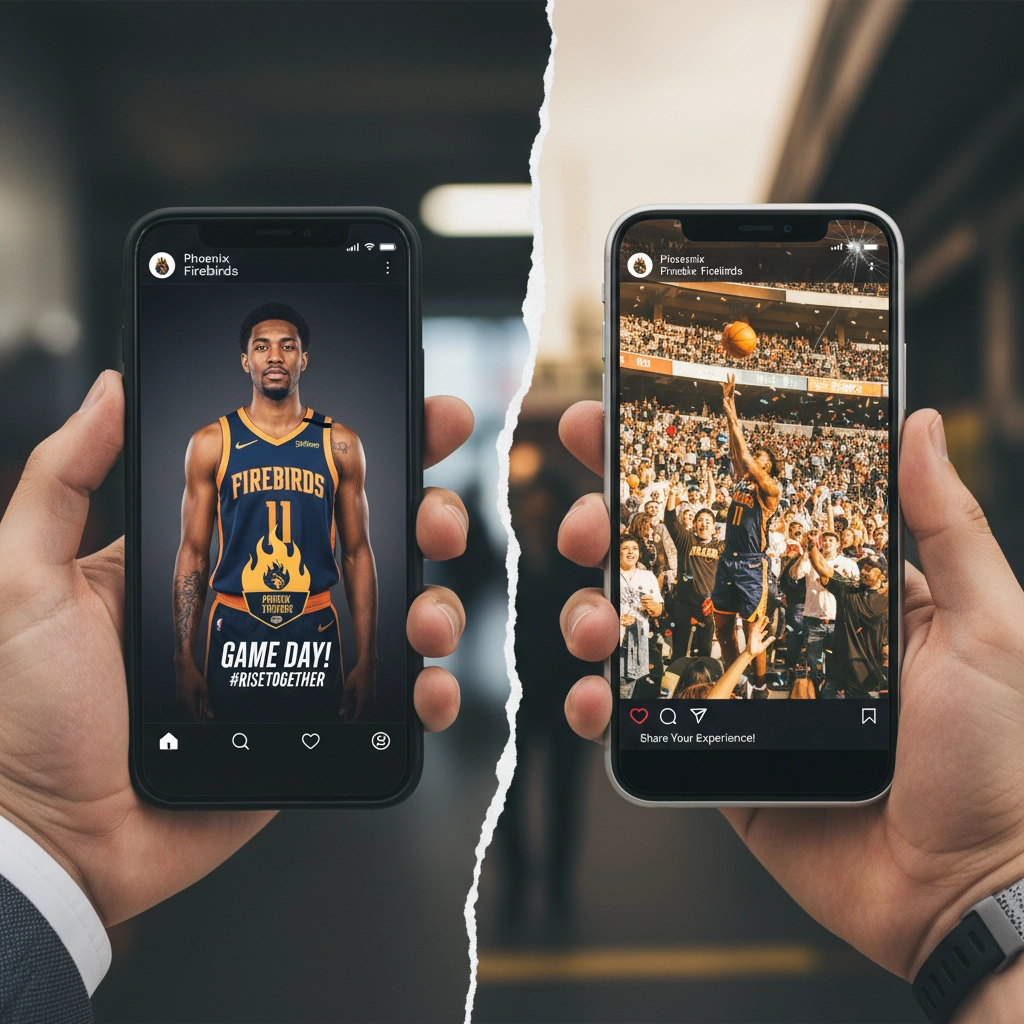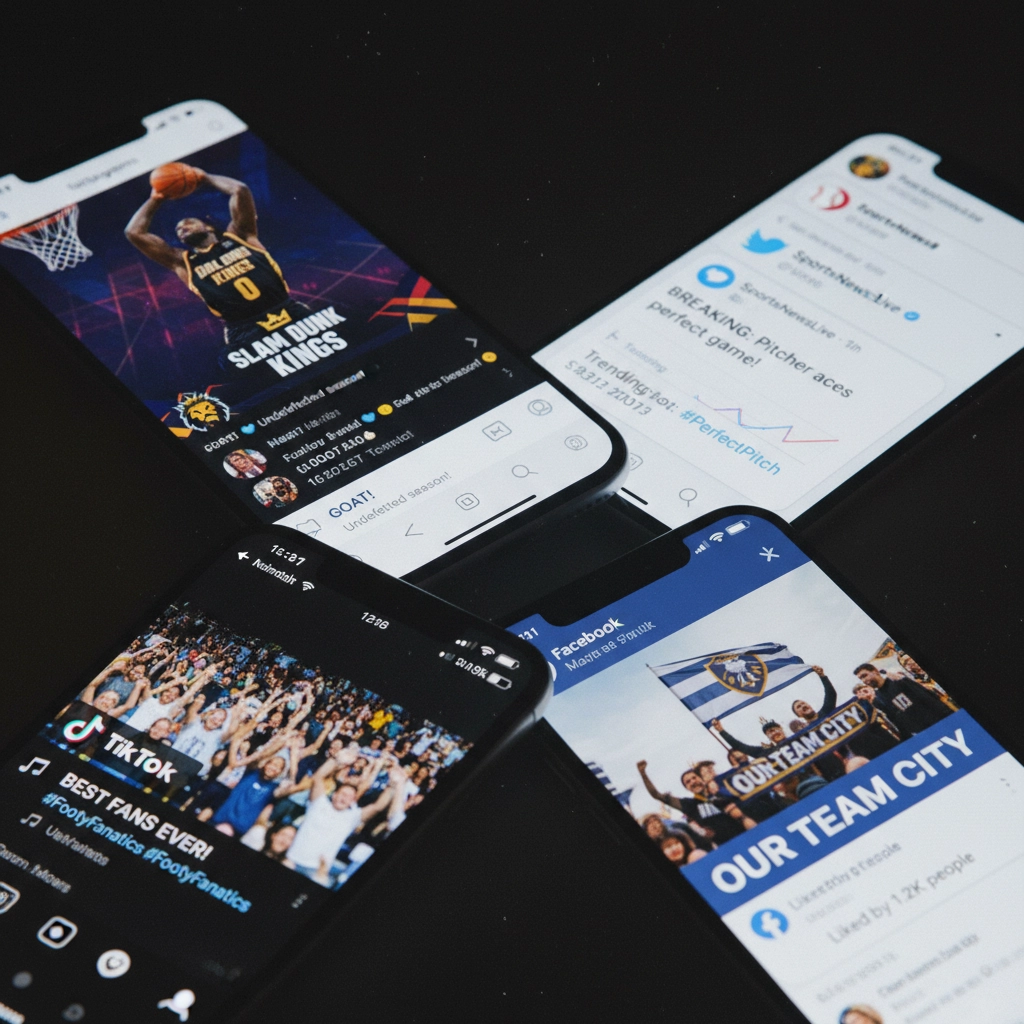The engagement performance between user-generated content and professional posts presents measurable differences across social media platforms. Sports brands require data-driven insights to determine content strategies that optimize fan interaction rates.
Engagement Statistics Overview
User-generated content demonstrates superior engagement metrics compared to professionally produced content. Research indicates UGC generates 28% higher engagement rates than traditional branded content across multiple platforms. Sports brands utilizing UGC strategies report 50% increases in overall engagement metrics, with Instagram posts featuring user-generated elements receiving 70% more interactions than standard professional posts.
Professional content maintains specific advantages in controlled messaging scenarios. However, engagement rates consistently favor authentic, user-created materials across demographic segments and platform types.

User-Generated Content Analysis
User-generated content encompasses posts, images, videos, and testimonials created by fans, athletes, and community members rather than brand marketing teams. This content category includes fan reactions, athlete lifestyle posts, game-day experiences, and community-driven discussions.
Performance Metrics
UGC campaigns demonstrate quantifiable engagement advantages. Conversion rates increase by 29% when user-generated elements are incorporated into marketing strategies. Consumer trust metrics show 60% of audiences consider UGC the most authentic content format available.
Marketing professionals report positive outcomes from UGC integration. 93% of marketers utilizing user-generated strategies indicate performance improvements compared to traditional branded approaches. The influence factor measures 10 times higher for UGC compared to standard influencer content in purchase decision processes.
Platform-Specific Performance
Instagram demonstrates the strongest UGC engagement patterns. Posts incorporating user-generated elements achieve 70% higher interaction rates than professionally produced content. TikTok shows similar trends, with authentic fan content outperforming branded material by significant margins.
Twitter engagement favors real-time user reactions and community discussions. Sports events generate substantial UGC volume, with fan posts receiving higher retweet and reply rates than official team announcements.
Content Categories
Fan reactions during live sports events generate high engagement volumes. Game-day experiences shared by attendees create authentic connections with broader fan communities. Athlete lifestyle content posted by players themselves outperforms official team content consistently.
Community challenges and fan-generated hashtags demonstrate sustained engagement over extended periods. User-submitted photos and videos from sporting events achieve broader reach than professionally produced highlight reels.

Professional Content Analysis
Professional content includes officially produced materials created by marketing teams, agencies, and content specialists. This category encompasses high-production videos, branded graphics, official announcements, and polished promotional materials.
Performance Characteristics
Professional posts maintain consistent quality standards and brand messaging alignment. Production values remain high, with controlled narratives and strategic messaging delivery. However, engagement rates typically measure lower than user-generated alternatives across most platform metrics.
Cost factors for professional content creation require significant resource allocation. Production timelines extend longer than UGC alternatives, with complex approval processes affecting publication schedules.
Strategic Applications
Professional content serves specific marketing objectives effectively. Product launches require controlled messaging and high production values. Complex information delivery benefits from professional formatting and clear presentation structures.
Brand positioning initiatives rely on professional content for consistent visual identity maintenance. Corporate communications require professional standards for credibility and authority establishment.
Quality Control Benefits
Professional content eliminates variability in messaging and presentation quality. Brand guidelines receive consistent application across all materials. Legal compliance and regulatory requirements are addressed systematically through professional production processes.
Message accuracy and fact-checking procedures ensure reliable information delivery. Professional oversight prevents potential reputation risks associated with uncontrolled content creation.
Comparative Performance Analysis
| Metric | User-Generated Content | Professional Posts |
|---|---|---|
| Engagement Rate Increase | +28-50% vs branded content | Baseline measurement |
| Authenticity Perception | 60% consumer preference | Lower authenticity ratings |
| Conversion Impact | +29% conversion rates | Standard performance levels |
| Production Costs | Minimal financial investment | High resource requirements |
| Brand Message Control | Limited oversight capability | Complete message management |
| Influence on Decisions | 10x higher than influencer content | Standard influence metrics |
| Content Quality Consistency | Variable quality levels | Consistent professional standards |
| Publication Timeline | Immediate availability | Extended production schedules |

Platform-Specific Engagement Patterns
Different social media platforms demonstrate varying engagement preferences between UGC and professional content. Instagram users respond more favorably to authentic, unpolished content that appears genuine and spontaneous. TikTok algorithms prioritize engaging, authentic content over polished professional productions.
Facebook engagement patterns show mixed results, with professional content performing adequately for announcements while UGC drives higher interaction rates for community building. YouTube demonstrates platform-specific preferences, with professional content succeeding for educational materials while UGC performs better for reaction and community content.
LinkedIn maintains preference patterns favoring professional content for business communications, while personal professional experiences generate higher engagement than corporate announcements.
Content Strategy Recommendations
High UGC Scenarios
Sports brands should prioritize user-generated content strategies for community building initiatives. Fan engagement campaigns benefit from UGC integration, particularly during active sports seasons and major events.
Budget-conscious marketing approaches should emphasize UGC utilization for cost-effective engagement generation. Social media campaigns targeting younger demographics show improved performance with authentic, user-created materials.
Trust-building initiatives require authentic customer experiences shared through user-generated formats. Community loyalty development benefits from featuring fan contributions and recognizing community participants.
Professional Content Applications
Official announcements require professional content standards for credibility maintenance. Product launches benefit from controlled messaging and high production values that professional content provides.
Complex information delivery necessitates professional formatting for clarity and comprehension. Brand positioning initiatives require consistent visual identity maintenance through professional production standards.
Regulatory compliance scenarios mandate professional oversight and quality control measures. Corporate communications targeting business audiences maintain credibility through professional presentation standards.

Implementation Strategies
Successful content strategies incorporate both UGC and professional elements strategically. Sports brands should establish clear guidelines for encouraging user-generated contributions while maintaining brand alignment standards.
Content curation processes should identify high-quality user submissions for amplification across official channels. Professional content should complement UGC efforts rather than compete for the same engagement objectives.
Measurement systems should track both engagement metrics and brand objective achievement to optimize content mix ratios. Regular performance analysis enables strategy adjustments based on audience response patterns and platform algorithm changes.
Audience Response Patterns
Consumer behavior analysis indicates preference variations across demographic segments. Younger audiences demonstrate stronger preference for authentic, unpolished content formats. Professional demographics maintain appreciation for high-quality, well-produced materials.
Geographic variations affect content preference patterns, with some markets showing stronger UGC engagement while others prefer professional presentation standards. Cultural factors influence authenticity perception and engagement response rates.
Sports fan communities generally favor authentic experiences and behind-the-scenes content over polished promotional materials. However, educational content and rule explanations perform better in professional formats for clarity and authority.
The data consistently demonstrates user-generated content's superior engagement performance across most metrics and platforms. Sports brands should prioritize UGC integration while maintaining professional content for specific strategic applications requiring controlled messaging and high production standards.
